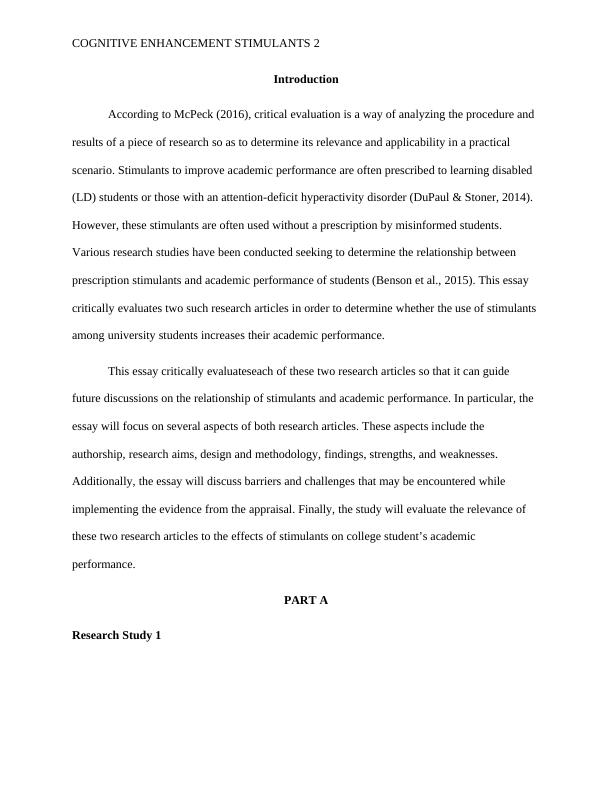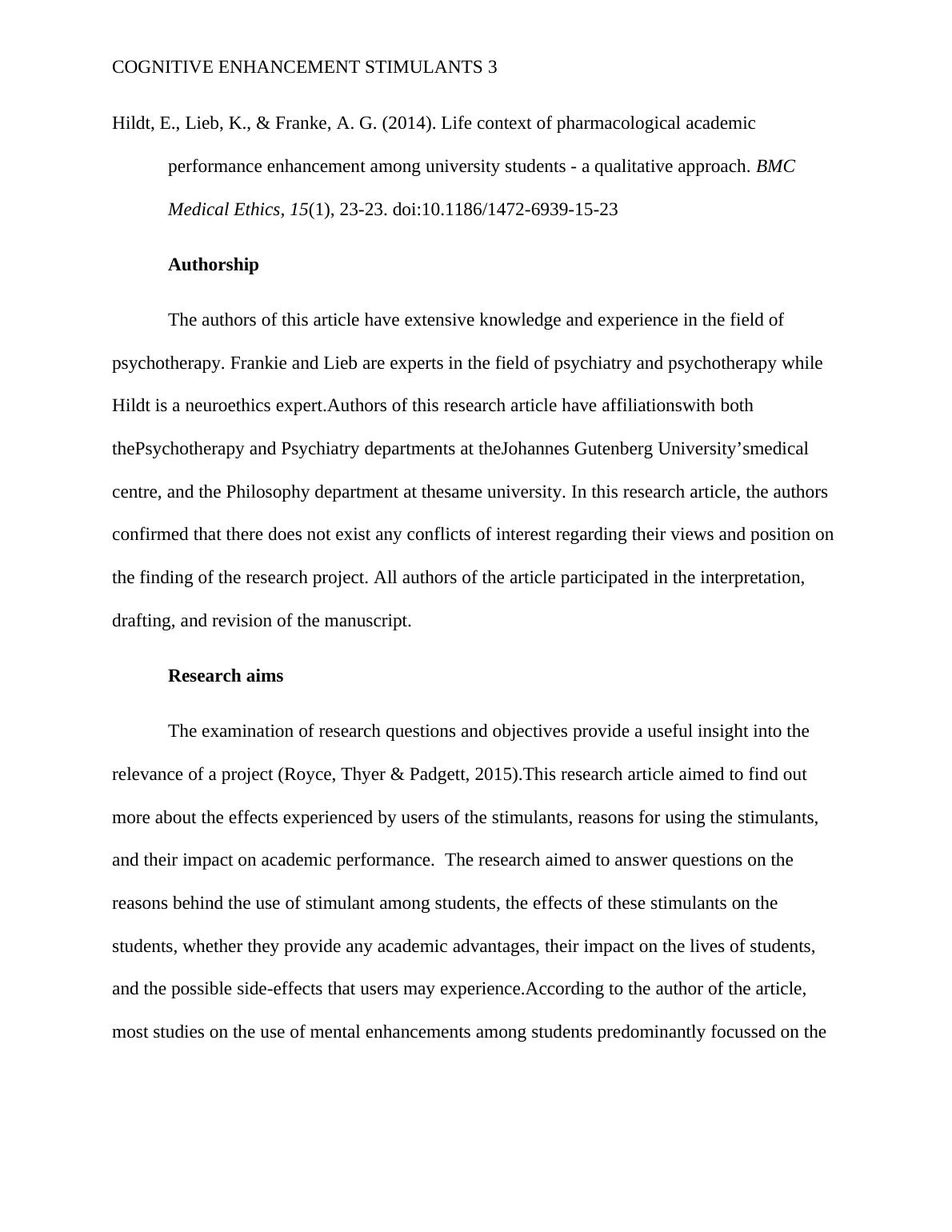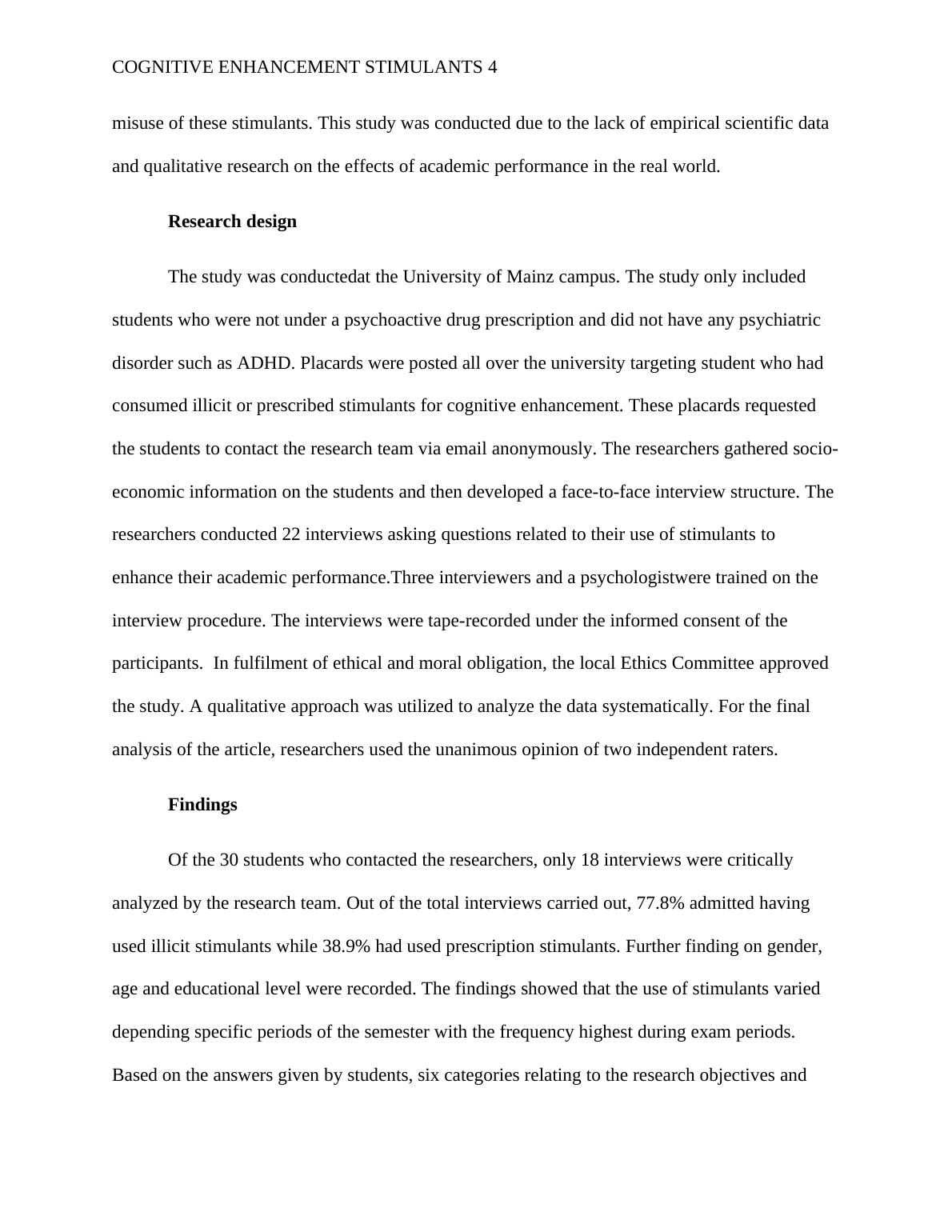HLSC122: Evidence For Practice Nursing Assignment
Added on 2020-05-01
11 Pages2726 Words67 Views
Running head: COGNITIVE ENHANCEMENT STIMULANTS1An Evaluation of the effects of Stimulants on Academic PerformanceNameInstitutional Affiliation

COGNITIVE ENHANCEMENT STIMULANTS 2IntroductionAccording to McPeck (2016), critical evaluation is a way of analyzing the procedure and results of a piece of research so as to determine its relevance and applicability in a practical scenario. Stimulants to improve academic performance are often prescribed to learning disabled (LD) students or those with an attention-deficit hyperactivity disorder (DuPaul & Stoner, 2014). However, these stimulants are often used without a prescription by misinformed students. Various research studies have been conducted seeking to determine the relationship between prescription stimulants and academic performance of students (Benson et al., 2015). This essay critically evaluates two such research articles in order to determine whether the use of stimulants among university students increases their academic performance.This essay critically evaluateseach of these two research articles so that it can guide future discussions on the relationship of stimulants and academic performance. In particular, the essay will focus on several aspects of both research articles. These aspects include the authorship, research aims, design and methodology, findings, strengths, and weaknesses. Additionally, the essay will discuss barriers and challenges that may be encountered while implementing the evidence from the appraisal. Finally, the study will evaluate the relevance of these two research articles to the effects of stimulants on college student’s academic performance.PART AResearch Study 1

COGNITIVE ENHANCEMENT STIMULANTS 3Hildt, E., Lieb, K., & Franke, A. G. (2014). Life context of pharmacological academic performance enhancement among university students - a qualitative approach. BMC Medical Ethics, 15(1), 23-23. doi:10.1186/1472-6939-15-23AuthorshipThe authors of this article have extensive knowledge and experience in the field of psychotherapy. Frankie and Lieb are experts in the field of psychiatry and psychotherapy while Hildt is a neuroethics expert.Authors of this research article have affiliationswith both thePsychotherapy and Psychiatry departments at theJohannes Gutenberg University’smedical centre, and the Philosophy department at thesame university. In this research article, the authors confirmed that there does not exist any conflicts of interest regarding their views and position on the finding of the research project. All authors of the article participated in the interpretation, drafting, and revision of the manuscript. Research aimsThe examination of research questions and objectives provide a useful insight into the relevance of a project (Royce, Thyer & Padgett, 2015).This research article aimed to find out more about the effects experienced by users of the stimulants, reasons for using the stimulants, and their impact on academic performance. The research aimed to answer questions on the reasons behind the use of stimulant among students, the effects of these stimulants on the students, whether they provide any academic advantages, their impact on the lives of students, and the possible side-effects that users may experience.According to the author of the article, most studies on the use of mental enhancements among students predominantly focussed on the

COGNITIVE ENHANCEMENT STIMULANTS 4misuse of these stimulants. This study was conducted due to the lack of empirical scientific data and qualitative research on the effects of academic performance in the real world. Research designThe study was conductedat the University of Mainz campus. The study only included students who were not under a psychoactive drug prescription and did not have any psychiatric disorder such as ADHD. Placards were posted all over the university targeting student who had consumed illicit or prescribed stimulants for cognitive enhancement. These placards requested the students to contact the research team via email anonymously. The researchers gathered socio-economic information on the students and then developed a face-to-face interview structure. The researchers conducted 22 interviews asking questions related to their use of stimulants to enhance their academic performance.Three interviewers and a psychologistwere trained on the interview procedure. The interviews were tape-recorded under the informed consent of the participants. In fulfilment of ethical and moral obligation, the local Ethics Committee approved the study. A qualitative approach was utilized to analyze the data systematically. For the final analysis of the article, researchers used the unanimous opinion of two independent raters.FindingsOf the 30 students who contacted the researchers, only 18 interviews were critically analyzed by the research team. Out of the total interviews carried out, 77.8% admitted having used illicit stimulants while 38.9% had used prescription stimulants. Further finding on gender, age and educational level were recorded. The findings showed that the use of stimulants varied depending specific periods of the semester with the frequency highest during exam periods. Based on the answers given by students, six categories relating to the research objectives and

End of preview
Want to access all the pages? Upload your documents or become a member.
Related Documents
Critical Evaluation of Evidence Essaylg...
|9
|2316
|110
The Essay on Case Scenario of Wasimlg...
|12
|2968
|139
Critical evaluation of evidence: Barriers for the application of evidence in academic researchlg...
|12
|2850
|290
Nursing Assignment | Health Case Studylg...
|12
|2674
|129
HLSC122 Critical Evaluation of Evidencelg...
|11
|2601
|57
Critical Evaluation of Evidence Word count: Unit: HLSC122 Semester 2, 2017 Assessment 3: Critical Evaluation of Evidence Word count: Introductionlg...
|13
|3051
|356
